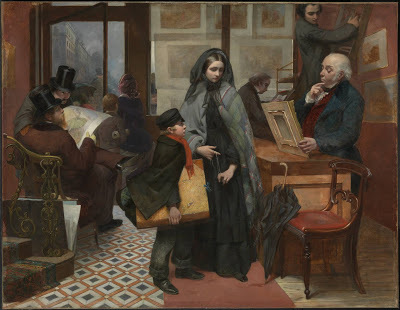When a Victorian Painting Isn't What It Seems

Isabella reporting,
Some of the most popular 19thc painters were storytellers as well as artists, filling their realistic canvases with characters and symbolism that gallery-goers of the time could "read" as clearly as if the paintings were books. Poignant farewells, heroic soldiers , thwarted lovers, fallen women , scenes from history and from current events all found their place in these often-oversized, detailed paintings.
When I recently came across the painting, above, on Twitter, I was sure I understood the story it told. Even the title with its Biblical quotation seemed filled with obvious meaning: Nameless and Friendless: "The rich man's wealth is his strong city" - Proverbs X, 15. (As always, please click on the image to enlarge it.) Painted by Emily Mary Osborn in 1857, I thought it must be a poignant representation of a young widow forced to sell her belongings to survive. Her somber clothes must be a stage of mourning, and her melancholy expression hints at painful memories of happier times. Perhaps the painting that the gallery owner is appraising was even a favorite of her late husband.

And wow, was I ever wrong.
To learn the real subject of this painting, go to
But before you go over there - what do you see in this painting?
Above: Nameless and Friendless: "The rich man's wealth is his strong city" - Proverbs X, 15 by Emily Mary Osborn, 1857, The Tate.
Published on July 27, 2016 21:00
No comments have been added yet.



